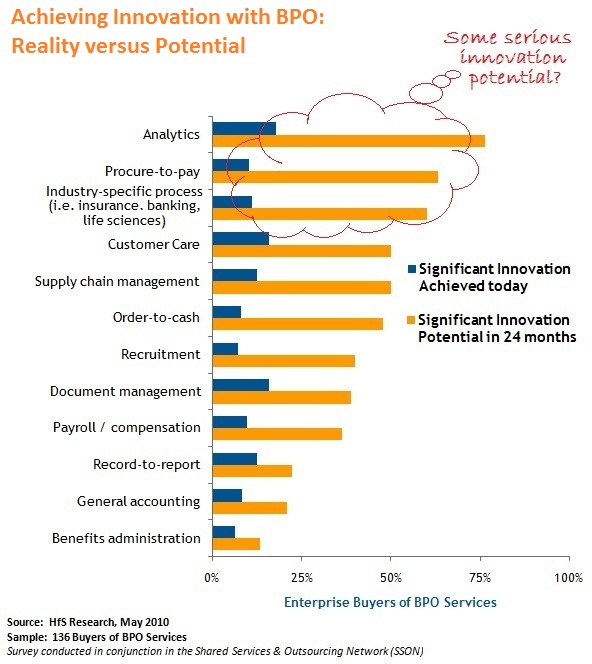
Now there's some significant innovation potential…
When it comes to achieving innovation when outsourcing, buyers need to identify where real innovation is possible, and where they only really need operational efficiency.
Innovation is about deploying creative and unique methods to drive new productivity or top line growth into the company. In reality, some processes have that potential, while others, quite frankly, only offer a means to an end.
Our new innovation study, conducted in conjunction with our BPO networking partner, the Shared Services & Outsourcing Network, reveals some staggering results from 136 senior BPO buyers, when we asked them where they were achieving significant innovation today, and where they saw the potential to achieving significant innovation within a two-year time frame:
Determine the ceiling of innovation value
This data reveals an awful lot about outsourcing today. Essentially, most business processes can be improved to a certain extent when they are outsourced, whether it be through better workflows, application of new technology, and domain knowledge from experts. And most buyers today still feel most – or all – of their outsourced processes can benefit from further innovation.
However, some processes clearly have a ceiling of innovation value that can be attained, which is where the move towards standardization comes into play. For example, once you’ve got a benefits or payroll solution that delivers the required functionality, is delivered via a hosted / SaaS model, and the provider has the costs and service quality performing to an acceptable level, is there really a whole lot more value your business can gain from them, to increase productivity further and drive new top-line growth? Cloud Computing and SaaS can further help drive down the operating costs and optimization of delivery, but once you’re happy with the processes and the service, that may be the limit of future innovative value that you can expect to attain.
Pinpoint where future growth and productivity can be attained with a BPO provider
Where there is significant opportunity to achieve innovation, is where there is significant room to improve process flows, add domain knowledge, creativity and technology into the mix to achieve impactful business outcomes. This is especially prevalent with those processes that are often a long way from standardization, and can benefit from consultative business partners to develop a specific innovation agenda (see Part II). Analytics innovation clearly represents a major opportunity for providers and buyers to work together to make better use of information to drive results, in a cost-efficient manner. It also encompasses a much greater need for consultative support from the provider. And it’s the same story as you go through those processes where the innovation opportunity is significant, for example, P2P (massive productivity and cash flow); supply chain (driving product to market quicker); customer–care (driving new income), recruiting (reducing time-to-hire and improving talent selection), and so on. Each innovation gap tells a story of where the future value lies.
The HfS Viewpoint: The key lies in determining and achieving the right balance between operational efficiency and innovative value. Both are crucial.
That means, when selecting BPO partners to drive new business value, buyers need to focus on identifying which ones can genuinely help them innovate, versus those who can keep the machine cranking. In most cases today, buyers are increasingly finding they can source to multiple BPO and consulting partners – those to help them innovate in processes that have real value-potential, and those which can keep the costs down and the operations functioning. Many buyers today with some BPO experience, are now seriously considering adding more competitiveness to their provider mix to get more creative value.
On the flip-side, providers need to determine where they add the most value. For example, ADP has the lion’s share of the managed payroll business – so does it need to broaden beyond that into adjacent processes, for example P2P, that requires greater innovative and consultative support? Cognizant has a strong portfolio of industry-specific offerings in verticals such as life sciences and banking – does it need to broaden more aggressively into more horizontal processes, such as F&A or procurement? Accenture and IBM have strong offerings across many of these processes, so where should they choose to invest more of their resources in a tightening market?
Buyers and providers need to work out a game-plan whereupon they determine what innovation is possible, and how it needs to be achieved. Some buyers feel they don’t need a hell of a lot of innovation, and some providers are happy delivering standard services with little innovation impetus, beyond a few basic requirements. In the future, we’ll be drawing up illustrations of the innovators and the operational players. There is room for both – the key is to determine how much focus to put into each area.
All-in-all: Both buyers and providers need to be honest with themselves to determine whether they are truly prepared to invest in either achieving or delivering innovation. If not, stick to being operationally efficient and stop talking about an innovation game-plan that will never happen.
Posted in : Business Process Outsourcing (BPO), Cloud Computing, Finance and Accounting, Financial Services Sourcing Strategies, Healthcare and Outsourcing, HR Outsourcing, kpo-analytics, Procurement and Supply Chain, SaaS, PaaS, IaaS and BPaaS, Sourcing Best Practises, sourcing-change








This is a must read for anyone in the BPO business! Bravo.
Paul
Might we also consider that process correction and application of lean models further the development of innovation opportunities. Until a critical assessment is rendered we simply can’t throw solutions at a service that may be in need of stabilization. You have however hit some of the innovation areas that are the sweet spots. Up to now there hasn’t been significant supply motivation to take the cash cow and make it produce less revenue but with better results for clients. Now we see that BPO optimization will buy bandwidth that yields higher ROI and if really on the edge the opening up of true KPO opportunities (and not just labeled KPO tasks).
[…] Horses for Sources (blog) […]
Very interesting, and excellent analysis, Phil. I would have thought recruitment would be higher in the foodchain here… am not surprised with analytics and P2P.
Dave Edwards
One day a son asked his father the difference between Potential & Reality. His father took him along and asked his wife, daughter & elder son if they would sleep with Brad Pitt for a million dollar. They all replied, sure!!!! The father replied to the young son, potentially we have 3 millionaires in the family but the reality is that we live with 2 prostitutes and a gay.
The purgatory BPO outlook is eating the low hanging fruits or eating anything that comes your way….
The analysis given is an eye opener. I am surprised to see Payroll & Cust Care having lower shares of the pie.
The market of low end outsourceable jobs is immense though unstable, KPO’s should see a new high in the emerging market post 2010.
Hoping to see such articles as a daily dose of wisdom.
Phil,
As clients work out their innovation-planning across different functions, they do need to understand the amount of business value that can be achieved by changing the process. Your mention of an “innovation ceiling” is powerful – it’s almost a reality check for businesses to pinpoint a satisfactory end-state with where they need/want that process to be in the future.
You also introduce a certain amout of reality with BPO – there is only so much you can achieve with certain processes – whether or not they operate in a BPO environent. Labor arbitrage offers a productivity lever, if managed well, but for further gains beyond that, it starts to get complicated for many – i.e. the introduction of better underpinning applications, or the efficiency gains of a Cloud model. By introducing a phased approach is compelling – i.e. “once we feel we have reached our innovation goals wiith this processes, what can we do next to find further value, or do we need to look at adjacent processes?” That’s why its so important to have service partners who are genuine “innovators” and not simply “operators”.
Thanks for a very, very insightful article,
Stephen.
Great piece of Research.
One area that I would add to the evaluation of process to apply innovation would be tied to the maturity of the process, rate of change to the process and customer requirements. There are many areas of analytics where the process is still in infancy stages. Innovation could be applied and in doing so make the process better but if the process then changes multiple times over the next couple of years, not sure the ROI will be there. Innovation is always great, but the degree of investment and the amount of change need to be directly proportionate with the return on that investment. Change for the sake of change isn’t the answer.
The other challenge that faces many providers today is that for many processes, the client has fragmented who performs the processes. This fragmentation happens between the client and potentially multiple providers. The more fragmented the process the larger the challenge for any one of these players to be able to create truly impactful improvements. The larger the scope of activities, the larger the opportunity for improvement; this could be though innovation or just basic process improvement.
My prediction is that clients are realizing this and for those areas that would like to see innovation, they will be centralizing more and more of the work within a designated Line of Business with a single provider as current contracts expire.
Just my two cents.
I dont think its an either or situation. It would be tough for a vendor to be a continous innovator and equally tough to survive as an pure executor. The mix between innovation – led by specific interventions like cloud or process re-engineering, and execution/change maangement through robust execution is what is lost when we focus on an either/or scenario
@Saju – I could not agree more with you!
[…] was the #1 business priority cited by 138 senior outsourcing buyers in a serious market survey published this month? […]
A very insightful article, Phil. There truly is significant opportunity to deliver value through “analytics-led innovation” across all areas of BPO. Service providers will have to integrate their analytics capabilities with business process operations to provide that much sought after game changing value to clients.
[…] As we discussed last year (read post here), at least 50% of clients take innovation very seriously when they outsource. And where they may […]